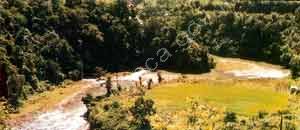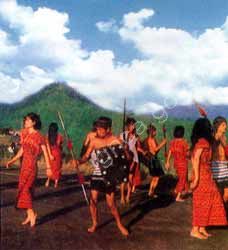Janapada Sampada

Mizoram, a mountainous region is sandwiched between Myanmar in the east and the south and Bangladesh and Tripura in the west with its northern frontiers touching Assam and Manipur states. Located in a strategic position, it has an 1100 km international boundary with Myanmar and Bangladesh. It was one of the districts of Assam until 1972 when it became a Union Territory.
After being annexed by the British in 1891, for the first few years, Lushai Hills in the north remained under Assam, while the southern half remained under Bengal. Both these parts were amalgamated in 1898 into one district called Lushai Hill District under the Chief Commissioner of Assam.
With the implementation of the North- Eastern Reorganization Act in 1972, Mizoram became a Union Territory and as a sequel to the signing of the historic memorandum of settlement between the Government of India and the Mizo National Front in 1986, it became the 23rd state of the Indian union on 20 February 1987. Mizoram literally translated means “Land of the Highlanders“. The hills are steep with an average height of 900 metres. The highest peak in Mizoram is the Blue Mountain (Phawngpui) with a height of 2210 metres. The tropical forests of Mizoram abound in a wide variety of flora and fauna. The thick bamboo groves strewn with wild plantations dominate the lower altitude, slowly giving way to dense woods festooned with creepers and canes as the hills rise higher. Orchids of various hues, pinkish- white bauthinia, sparkling rhododendrons, yellow sunflowers and many other colourful wild flowers, add a touch of delightful tonal contrasts to the greeneries. Besides being an ornithologist’s delight, the jungles are home to tigers, wild boars, leopards, monkeys, barking deers, sambars and elephants.
Historians believe that the Mizos are a part of the great wave of the Mongolian race spilling over the eastern and southern India centuries ago. Their sojourn in western Myanmar, into which they eventually drifted around the 7th century, is estimated to last about 10 centuries. Mizo is not just one tribe as normally presumed but the term represents several tribes taken together. The term Mizo means “the “men who live in the hills”(Mi- men; Zo- hills) or the Highlanders. Mizo comprises of 5 major tribes and 11 minor tribes known under the common name Awzia. The 5 major tribes are- Lushei, Ralte, Hmar, Paihte, Pawi (or Poi). While major tribes maintained their respective dialects, the 11 minor tribes either lost their distinctive dialects as a result of association with larger tribes.

Mizos are of Mongoloid origin, speaking a dialect of Tibeto- Burman origin. The Mizos came under the influence of the British missionaries in the 19th century and today the majority of the Mizos are Christians by faith. The literacy rate is the second highest in the country. The people are mostly non- vegetarian and their staple food is rice. The Mizos are a close- knit society with no class distinction and discrimination on grounds of sex, status or religion. They are hospitable, sociable and love music, singing and dancing. Mizos are agriculturists, practising what is known as “Jhum Cultivation”or slash- and- burn system of cultivation. They cut down the jungles, burn the dried trunks and leaves and then till the soil. All their activities revolve around this cultivation and their festivals are connected with such agricultural operations.
The fabric of social life in the Mizo society has undergone tremendous changes over the years. Before the British moved into the hills, for all practical purposes the village and the clan became units of the Mizo society. The Mizo code of ethics or dharma moved round “Tlawmngaihna“an untranslatable term meaning on the part of everyone to be hospitable, kind unselfish and helpful to others. Tlawmngaihna to a Mizo stands for selfless service for others.

A gregarious and close- knit society, they evolved some principles of self-help and co- operation to meet social obligations and responsibilities. Constructive social works were executed through voluntary community works known as Hnatlang. Every family was expected to contribute labour for the welfare of the community and participate in Hnatlang. The spirit of Hnatlang combined with Tlawmngaihna makes it mandatory for the Mizos to render all possible help on occasions of marriage, public feast, accident and death.
The Mizos are a distinct community and the social unit was the village. Around it revolved the life of the Mizo. Mizo village is generally set on top of a hill with the chief’s house at the centre and the bachelor’s dormitory called Zwalbuk, prominently located in a central place. In a way, the focal point in the village was the Zwalbuk where all young bachelors of the village slept. Zwalbuk was the training ground and indeed the cradle wherein the Mizo youth was shaped into a responsible adult member of the society.
Until today the old belief, Pathian is still in use to term God. The Mizos have been enchanted to their new- found faith of Christianity with so much dedication and submission that their social life and thought- process have been altogether transformed and guided by the Christian church organisations directly or in directly and their sense of values has also undergone drastic change.
No class distinction and no discrimination on grounds of sex are not seen in Mizo society. 90% of them are cultivators and the village exists like a big family. Birth of a child, marriage in the village and death of a person in the village or a community feast arranged by a member of the village are important occasions in which the whole village is involved.
Agriculture is the mainstay for about 60% of the population of Mizoram. Only 5% of the total area is under cultivation. About 7% of the total cultivated area is under irrigation. Maize and paddy are cultivated in the hill slopes. Pulses, sugarcanes, chillies, ginger, tobacco, vegetables, turmeric, potato, banana and pineapple are the other crops grown in the state. Forest account for nearly 21% of the area.

Mizoram has no major industry. It has remained backward industrially which can be attributed to physical alienation, lack of mineral resources in the state, distance from the heart of the country coupled with communication, etc. The cottage industries comprise of handloom and handicrafts. In the small scale sector are the rice- milling, oil and flour milling, mechanised bamboo workshops, saw milling, brick making and furniture workshops.

The Mizos have three main festivals- Mim Kut, Chapchar Kut and Pawl. These festivals or Kuts as they call them are in one way or another associated with their agricultural activities.
Chapchar Kut: Among many other festivals, Chapchar Kut or Spring Festival, is the most popular festival, celebrated after completion of their most arduous task of jungle clearing for “jhum” operations. On this day, people of all ages, young and old, men and women, dressed in their respective colourful costumes and head- gears, assemble and perform various folk dances, sing traditional songs accompanied by the beating sound of drums, gongs and cymbals.
Mim Kut: Mim Kut or Maize festival is celebrated during the months of August and September, after the harvest of maize. Mim Kut is celebrated with great fanfare by drinking rice- beer, singing, dancing and feasting. Sample of the year’s harvests are consecrated to the departed souls of the community.
Mizos are fast giving up their old customs and adopting the new mode of life that is greatly influenced by the western influenced by the western culture. Many of their present customs are mixtures of their old tradition and western pattern of life. Music is a passion of the Mizos. The most colourful and distinctive dance of the Mizo is called Cheraw. Long bamboo staves are used for this dance, therefore many people call it ‘ Bamboo Dance’.

Aizawl (capital; religious and cultural centre of Mizoram); Champhai (beautiful resort on the Indo- Myanmar border, 192 kms away from Aizawl); Lunglei (hill station); Tamdil Lake (natural lake with virgin forest around); Vantawng Waterfalls (near the town of Thenzawl); Saitual (tourist resort); Rengdil (bird sanctuary).




